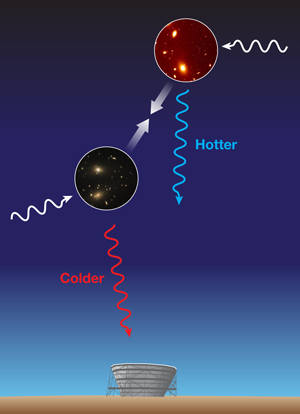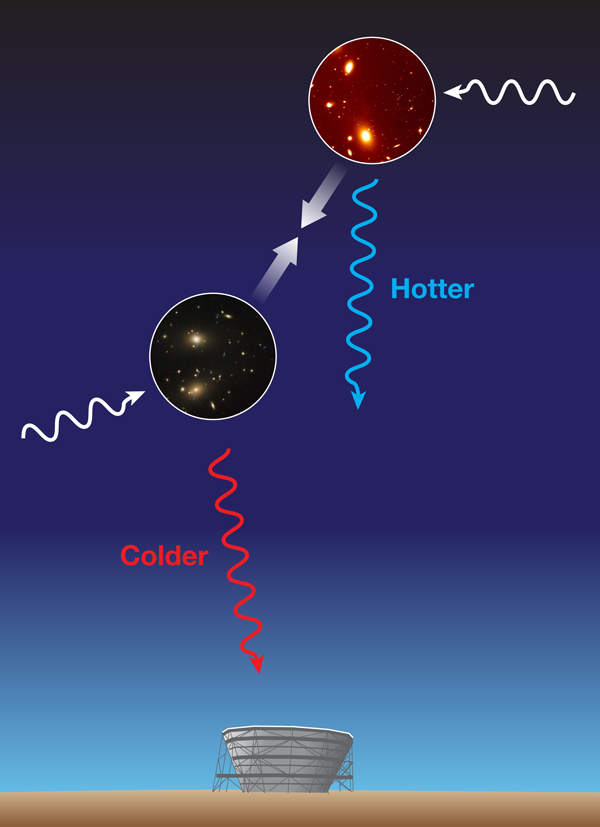Cosmic Microwave Background Carries Imprint of Moving Galaxies
The cosmic microwave background (CMB)—relic photons from the early stages of the universe—is well established as a precise probe of cosmology, providing a clear picture of the universe when it was th its current size. A new generation of experiments now makes it possible to also use the CMB to probe large-scale structure, like galaxies and galaxy clusters, in those parts of the universe that are relatively close by. In Physical Review Letters [1], an international team of researchers (Hand et al.) reports they have been able to detect the tendency of large clumps of matter to move toward each other using CMB data collected by the Atacama Cosmology Telescope (ACT) and a large galaxy catalog compiled by the Baryon Oscillation Spectroscopic Survey (BOSS), an experiment designed to detect the imprint of early universe sound waves in the local galaxy distribution. Measurements like these provide new tests of gravity on large scales as well as a different perspective on dark energy, the strange form of energy density that appears to be driving the accelerating expansion of the universe.
Measurements of the CMB have advanced in both sensitivity and angular resolution, to the point where it is now possible to not only characterize the density fluctuations that existed in the early universe but also measure the subtle distortions of the CMB caused by photons interacting with large clumps of matter in the relatively local universe. Compared to other methods of observing galaxy distributions, CMB measurements are sensitive to different aspects of the process of structure formation and at different cosmic epochs, and are therefore complementary probes of cosmology. One such example is the gravitational lensing of the CMB, where the gravity from large-scale density fluctuations distorts and magnifies the temperature anisotropies imprinted in the early universe. The first detection of this effect [2] used data from the Wilkinson Microwave Anisotropy Probe [3]. Subsequent measurements by the ACT [4] (see 5 July 2011 Viewpoint) and the South Pole Telescope (SPT) [5] improved on this measurement.
In addition to experiencing the effects of gravity, photons from the early universe can inelastically scatter (Compton scattering) with the free electrons found in the highly ionized gasses in the local universe—a process generally known as the Sunyaev-Zel’dovich effect [6]. When the interaction is between relatively cold CMB photons and hot electrons heated by gravitational compression, it is known as the thermal Sunyaev-Zel’dovich effect, and has been well studied in the past few decades. In recent years, the SPT, ACT, and Planck satellite have used the effect to discover new massive clusters of galaxies in CMB maps [7–9].
Photons can also scatter from clouds of electrons with a bulk velocity , but this so-called kinematic Sunyaev-Zel’dovich effect has never before been detected. The source of the effect is that clouds of electrons moving away from the observer will lead to a slight redshifting of the scattered photons, while clouds moving toward the observer will cause a slight blueshift (Fig.1). The magnitude of this effect is of order ( , based on what is known about cosmological bulk flows) times the scattering probability ( for a cluster of galaxies). What this means for a CMB with an average temperature of kelvin is that the photons will be shifted by of order . The recent results of Hand et al. use the combination of ACT data and the BOSS experiment to provide the first detection of this effect.
Hand et al.’s approach to detecting the effect is quite robust. Galaxies and galaxy clusters are regions of enhanced mass density, so galaxies or galaxy clusters that are close to each other should be attracted to each other. Considering an observer looking out at two galaxies that are near to each other, the more distant one should appear to fall toward the nearer one (and toward the observer), while the closer galaxy should appear to move away from the observer. The free electrons associated with each galaxy should, similarly, have opposite velocities, leading to a distinct anticorrelation between the observed microwave background temperatures at the location of those galaxies. The sign of the effect is well defined (the more distant object should be blueshifted compared to the less distant one), and the spatial dependence can also be predicted (more widely separated pairs should have less relative velocity), so even though the signal for any one pair of galaxies is small, measurements can average over many pairs to produce a detection.
After averaging over galaxies, Hand et al. do indeed find a clear detection of the kinetic Sunyaev-Zel’dovich effect, with an amplitude that is in agreement with expectations from simulations of the large scale structure in the universe. Since it is an independent cosmological probe, the detection is a great success for the cosmological model, which assumes there is a mix of dark matter and dark energy. Alternatives to dark energy and dark matter often predict a different growth rate for cosmic structure than what is predicted by the standard cosmological model; Hand et al.’s work provides a means to test these ideas. Their results also point the way toward a new probe of gravity and cosmology. With more sensitive CMB maps and upcoming wide-area galaxy surveys that extend to higher redshift, it will be possible to directly measure gravitational accelerations at large separations. Such measurements will permit tests of general relativity on extremely large scales [10].
CMB experiments continue to improve and refine our understanding of the early universe and are helping us search for the signature of gravitational radiation from the first moments of the universe. We can also expect rapid improvements in CMB measurements of the local universe. The SPT experiment has an existing large data set that is well-suited for this purpose, and both SPT and ACT have completed major upgrades to enhance their sensitivity and the speed with which they can map portions of the universe. Thus, as we learn more about the first moments of the universe, we can also get new views of the universe today.
References
- N. Hand et al., ”Evidence of Galaxy Cluster Motions with the Kinematic Sunyaev-Zel’dovich Effect,” Phys. Rev. Lett. 109, 041101 (2012)
- K. M. Smith, O. Zahn, and O. Doré, “Detection of Gravitational Lensing in the Cosmic Microwave Background,” Phys. Rev. D 76, 043510 (2007)
- C. L. Bennett et al., “First-Year Wilkinson Microwave Anisotropy Probe (WMAP) Observations: Preliminary Maps and Basic Results,” Astrophys. J. Suppl. Ser. 148, 1 (2003)
- S. Das et al., “Detection of the Power Spectrum of Cosmic Microwave Background Lensing by the Atacama Cosmology Telescope,” Phys. Rev. Lett. 107, 021301 (2011)
- A. van Engelen et al., “A measurement of gravitational lensing of the microwave background using South Pole Telescope data,” arXiv:1202.0546 (2012)
- R. A. Sunyaev and Y. B. Zel’dovich, Comments Astrophys. Space Phys. 4, 173 (1972)
- Z. Staniszewski et al., “Galaxy Clusters Discovered With a Sunyaev-Zel’dovich Effect Survey,” Astrophys. J. 701, 32 (2009)
- T. A. Marriage et al., “The Atacama Cosmology Telescope: Sunyaev-Zel’dovich-Selected Galaxy Clusters at 148 GHz in the 2008 Survey,” Astrophys. J. 737, 61 (2011)
- P. A. R. Ade et al. (Planck Collaboration), Planck Early Results. XXIII. The First All-Sky Survey of Galactic Cold Clumps,” Astron. Astrophys. 536, A23 (2011)
- T. Clifton, P. G. Ferreira, A. Padilla, and C. Skordis, “Modified Gravity and Cosmology,” Phys. Rep. 513, 1 (2012)





